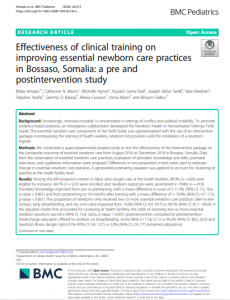
Background
Increasingly, neonatal mortality is concentrated in settings of conflict and political instability. To promote evidence-based practices, an interagency collaboration developed the Newborn Health in Humanitarian Settings: Field Guide. The essential newborn care component of the Field Guide was operationalized with the use of an intervention package encompassing the training of health workers, newborn kit provisions and the installation of a newborn register.
Methods
We conducted a quasi-experimental prepost study to test the effectiveness of the intervention package on the composite outcome of essential newborn care from August 2016 to December 2018 in Bossaso, Somalia. Data from the observation of essential newborn care practices, evaluation of providers’ knowledge and skills, postnatal interviews, and qualitative information were analyzed. Differences in two-proportion z-tests were used to estimate change in essential newborn care practices. A generalized estimating equation was applied to account for clustering of practice at the health facility level.
Results
Among the 690 pregnant women in labor who sought care at the health facilities, 89.9% (n = 620) were eligible for inclusion, 84.7% (n = 525) were enrolled, and newborn outcomes were ascertained in 79.8% (n = 419). Providers’ knowledge improved from pre to posttraining, with a mean difference in score of + 11.9% (95% CI: 7.2, 16.6, p-value < 0.001) and from posttraining to 18-months after training with a mean difference of + 10.9% (95% CI: 4.7, 17.0, p-value < 0.001). The proportion of newborns who received two or more essential newborn care practices (skin-to-skin contact, early breastfeeding, and dry cord care) improved from 19.9% (95% CI: 4.9, 39.7) to 94.7% (95% CI: 87.7, 100.0). In the adjusted model that accounted for clustering at health facilities, the odds of receiving two or more essential newborn practices was 64.5 (95% CI: 15.8, 262.6, p-value < 0.001) postintervention compared to preintervention. Predischarge education offered to mothers on breastfeeding 16.5% (95% CI: 11.8, 21.1) vs 44.2% (95% CI: 38.2, 50.3) and newborn illness danger signs 9.1% (95% CI: 5.4, 12.7) vs 5.0% (95% CI: 2.4, 7.7) remained suboptimal.
Conclusions
The intervention package was feasible and effective in improving essential newborn care. Knowledge and skills gained after training were mostly retained at the 18-month follow-up.